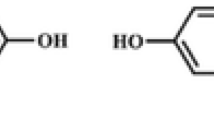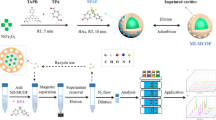Abstract
A fluorescent probe has been developed for tetra bromo bisphenol A (TBBPA) detection based on molecularly imprinted polymers (MIPs) combined with wrinkled silica nanoparticles (WSNs) and CdTe quantum dot (QD) hybrid particles. The WSNs with large pore sizes were employed as a structural support platform for QD embedding, and MIPs were synthesized on the surface of QD-embedded WSNs. The synthetic procedure was characterized using transmission electron microscopy, Brunauer–Emmett–Teller measurements, X-ray photoelectron spectrometry, Fourier transform infrared spectroscopy, and zeta potential analysis. The MIP-capped wrinkled silica-QD hybrid particles (WSNs-QDs-MIPs) possessed an adsorption capacity of 96.5 mg g−1 with an imprinting factor of 7.9 towards TBBPA. Under the optimum incubation conditions, the fluorescence intensity (λex = 340 nm, λem = 605 nm) was quenched in proportion to added TBBPA in the range 0.025 to 5 μM with a limit of detection of 5.4 nM. The developed probe was successfully applied to the detection of TBBPA in plastic electronic waste samples and the results of this method agreed with those obtained using high-performance liquid chromatography. This method presented a satisfactory selectivity, stability, and reproducibility indicating its potential as a promising probe for TBBPA detection.
Graphical abstract







Similar content being viewed by others
References
De Wit CA (2002) An overview of brominated flame retardants in the environment. Chemosphere 46:583–624. https://doi.org/10.1016/s0045-6535(01)00225-9
Wang W, Abualnaja KO, Asimakopoulos AG, Covaci A, Gevao B, Johnson-Restrepo B, Kumosani TA, Malarvannan G, Minh TB, Moon HB, Nakata H, Sinha RK, Kannan K (2015) A comparative assessment of human exposure to tetrabromobisphenol A and eight bisphenols including bisphenol A via indoor dust ingestion in twelve countries. Environ Int 83:183–191. https://doi.org/10.1016/j.envint.2015.06.015
Gao CJ, Xia LL, Wu CC, Wong CS, Guo Y (2019) The effects of prosperity indices and land use indicators of an urban conurbation on the occurrence of hexabromocyclododecanes and tetrabromobisphenol A in surface soil in South China. Environ Pollut 252:1810–1818. https://doi.org/10.1016/j.envpol.2019.06.128
Gorga M, Martinez E, Ginebreda A, Eljarrat E, Barcelo D (2013) Determination of PBDEs, HBB, PBEB, DBDPE, HBCD, TBBPA and related compounds in sewage sludge from Catalonia (Spain). Sci Total Environ 444:51–59. https://doi.org/10.1016/j.scitotenv.2012.11.066
Gustavsson J, Wiberg K, Ribeli E, Nguyen MA, Josefsson S, Ahrens L (2018) Screening of organic flame retardants in Swedish river water. Sci Total Environ 625:1046–1055. https://doi.org/10.1016/j.scitotenv.2017.12.281
Liu AF, Qu GB, Yu M, Liu YW, Shi JB, Jiang GB (2016) Tetrabromobisphenol-A/S and nine novel analogs in biological samples from the Chinese Bohai Sea: implications for trophic transfer. Environ Sci Technol 50:4203–4211. https://doi.org/10.1021/acs.est.5b06378
He M-J, Luo X-J, Yu L-H, Liu J, Zhang X-L, Chen S-J, Mai B-X (2010) Tetrabromobisphenol-A and hexabromocyclododecane in birds from an E-waste region in South China: influence of diet on diastereoisomer- and enantiomer-specific distribution and Trophodynamics. Environ Sci Technol 44:8357–8358. https://doi.org/10.1021/es1032597
Li A, Zhuang T, Shi W, Liang Y, Liao C, Song M, Jiang G (2020) Serum concentration of bisphenol analogues in pregnant women in China. Sci Total Environ 707:136100. https://doi.org/10.1016/j.scitotenv.2019.136100
Wang X, Wei L, Zhu J, He B, Kong B, Xue Z, Jin X, Fu Z (2019) Environmentally relevant doses of tetrabromobisphenol A (TBBPA) cause immunotoxicity in murine macrophages. Chemosphere 236:124413. https://doi.org/10.1016/j.chemosphere.2019.124413
Liang S, Zhou H, Yin N, Lu Y, Faiola F (2019) Embryoid body-based RNA-seq analyses reveal a potential TBBPA multifaceted developmental toxicity. J Hazard Mater 376:223–232. https://doi.org/10.1016/j.jhazmat.2019.05.030
Liang S, Liang S, Yin N, Hu B, Faiola F (2019) Toxicogenomic analyses of the effects of BDE-47/209, TBBPA/S and TCBPA on early neural development with a human embryonic stem cell in vitro differentiation system. Toxicol Appl Pharmacol 379:114685. https://doi.org/10.1016/j.taap.2019.114685
Li YT, Yang C, Ning JY, Yang YL (2014) Cloud point extraction for the determination of bisphenol A, bisphenol AF and tetrabromobisphenol a in river water samples by high-performance liquid chromatography. Anal Methods 6:3285–3290. https://doi.org/10.1039/c3ay42191k
Yin YM, Chen YP, Wang XF, Liu Y, Liu HL, Xie MX (2012) Dummy molecularly imprinted polymers on silica particles for selective solid-phase extraction of tetrabromobisphenol a from water samples. J Chromatogr A 1220:7–13. https://doi.org/10.1016/j.chroma.2011.11.065
Han F, Gao Y, Hu F, Yu X, Xie H, Li H, Zhao Y, Kimura SY, Zhang Y, Zubizarreta ME, Xiao S, Zhan M, Zheng W (2019) Solid-phase extraction of seventeen alternative flame retardants in water as determined by ultra-high-performance liquid chromatography-tandem mass spectrometry. J Chromatogr A 1602:64–73. https://doi.org/10.1016/j.chroma.2019.05.048
Shi T, Chen SJ, Luo XJ, Zhang XL, Tang CM, Luo Y, Ma YJ, Wu JP, Peng XZ, Mai BX (2009) Occurrence of brominated flame retardants other than polybrominated diphenyl ethers in environmental and biota samples from southern China. Chemosphere 74:910–916. https://doi.org/10.1016/j.chemosphere.2008.10.047
BelBruno JJ (2019) Molecularly imprinted polymers. Chem Rev 119:94–119. https://doi.org/10.1021/acs.chemrev.8b00171
Chen L, Wang X, Lu W, Wu X, Li J (2016) Molecular imprinting: perspectives and applications. Chem Soc Rev 45:2137–2211. https://doi.org/10.1039/c6cs00061d
Zheng L, Zheng Y, Liu Y, Long S, Du L, Liang J, Huang C, Swihart MT, Tan K (2019) Core-shell quantum dots coated with molecularly imprinted polymer for selective photoluminescence sensing of perfluorooctanoic acid. Talanta 194:1–6. https://doi.org/10.1016/j.talanta.2018.09.106
Huang S, Guo M, Tan J, Geng Y, Wu J, Tang Y, Su C, Lin CC, Liang Y (2018) Novel fluorescence sensor based on all-inorganic perovskite quantum dots coated with molecularly imprinted polymers for highly selective and sensitive detection of omethoate. ACS Appl Mater Interfaces 10:39056–39063. https://doi.org/10.1021/acsami.8b14472
Wei X, Zhou Z, Hao T, Li H, Xu Y, Lu K, Wu Y, Dai J, Pan J, Yan Y (2015) Highly-controllable imprinted polymer nanoshell at the surface of silica nanoparticles based room-temperature phosphorescence probe for detection of 2,4-dichlorophenol. Anal Chim Acta 870:83–91. https://doi.org/10.1016/j.aca.2015.02.025
Kresge CT, Leonowicz ME, Roth WJ, Vartuli JC, Beck JS (1992) Ordered mesoporous molecular sieves synthesized by a liquid-crystal template mechanism. Nature 359:710–712. https://doi.org/10.1038/359710a0
Zhao D, Feng J, Huo Q, Melosh N, Fredrickson GH, Chmelka BF, Stucky GD (1998) Triblock copolymer syntheses of mesoporous silica with periodic 50 to 300 angstrom pores. Science 279:548–552. https://doi.org/10.1126/science.279.5350.548
Wang Y, Du X, Liu Z, Shi S, Lv H (2019) Dendritic fibrous nano-particles (DFNPs): rising stars of mesoporous materials. J Mater Chem A 7:5111–5152. https://doi.org/10.1039/c8ta09815h
Singh R, Belgamwar R, Dhiman M, Polshettiwar V (2018) Dendritic fibrous nano-silica supported gold nanoparticles as an artificial enzyme. J Mater Chem B 6:1600–1604. https://doi.org/10.1039/c8tb00310f
Huo M, Wang L, Chen Y, Shi J (2017) Tumor-selective catalytic nanomedicine by nanocatalyst delivery. Nat Commun 8:357. https://doi.org/10.1038/s41467-017-00424-8
Chen F, Xiao F, Zhang W, Lin C, Wu Y (2018) Highly stable and NIR luminescent Ru-LPMSN hybrid materials for sensitive detection of Cu2+ in vivo. ACS Appl Mater Interfaces 10:26964–26971. https://doi.org/10.1021/acsami.8b08887
Mi C, Zhang J, Gao H, Wu X, Wang M, Wu Y, Di Y, Xu Z, Mao C, Xu S (2010) Multifunctional nanocomposites of superparamagnetic (Fe3O4) and NIR-responsive rare earth-doped up-conversion fluorescent (NaYF 4: Yb, Er) nanoparticles and their applications in biolabeling and fluorescent imaging of cancer cells. Nanoscale 2(7):1141–1148. https://doi.org/10.1039/C0NR00102C
Pang J, Zhou G, Liu R, Li T (2016) Esterification of oleic acid with methanol by immobilized lipase on wrinkled silica nanoparticles with highly ordered, radially oriented mesochannels. Mater Sci Eng C 59:35–42. https://doi.org/10.1016/j.msec.2015.09.088
Arshadi M, Salimi Vahid F, Salvacion JWL, Soleymanzadeh M (2013) A practical organometallic decorated nano-size SiO2–Al2O3 mixed-oxides for methyl orange removal from aqueous solution. Appl Surf Sci 280:726–736. https://doi.org/10.1016/j.apsusc.2013.05.052
Liu Y, Yin JY, Fu YB, Zhao PP, Zhang YH, He BQ, He PX (2020) Underwater superoleophobic APTES-SiO2/PVA organohydrogel for low-temperature tolerant, self-healing, recoverable oil/water separation mesh. Chem Eng J 382:122925. https://doi.org/10.1016/j.cej.2019.122925
Xu L, Pan M, Fang G, Wang S (2019) Carbon dots embedded metal-organic framework@molecularly imprinted nanoparticles for highly sensitive and selective detection of quercetin. Sens Actuators B Chem 286:321–327. https://doi.org/10.1016/j.snb.2019.01.156
Niu MC, Chuong PH, He H (2016) Core-shell nanoparticles coated with molecularly imprinted polymers: a review. Microchim Acta 183(10):2677–2695. https://doi.org/10.1007/s00604-016-1930-4
Li M, Sun P, Wu Q, Liu D, Zhou L (2018) Core–shell magnetic metal–organic framework molecularly imprinted nanospheres for specific adsorption of tetrabromobisphenol a from water. Environ Sci Nano 5(11):2651–2662. https://doi.org/10.1039/C8EN00806J
Wang YY, Liu GS, Hou XD, Huang YN, Li CY, Wu KB (2016) Assembling gold nanorods on a poly-cysteine modified glassy carbon electrode strongly enhance the electrochemical reponse to tetrabromobisphenol A. Microchim Acta 183(2):689–696. https://doi.org/10.1007/s00604-015-1708-0
Fu HJ, Wang Y, Xiao ZL, Wang H, Li ZF, Shen YD, Lei HT, Sun YM, Xu ZL, Hammock B (2020) A rapid and simple fluorescence enzyme-linked immunosorbent assay for tetrabromobisphenol a in soil samples based on a bifunctional fusion protein. Ecotoxicol Environ Saf 188:109904. https://doi.org/10.1016/j.ecoenv.2019.109904
Chen YP, Wang DN, Yin YM, Wang LY, Wang XF, Xie MX (2012) Quantum dots capped with dummy molecularly imprinted film as luminescent sensor for the determination of tetrabromobisphenol A in water and soils. J Agric Food Chem 60:10472–10479. https://doi.org/10.1021/jf3026138
Feng JW, Tao Y, Shen XL, Jin H, Zhou TT, Zhou YS, Hu LQ, Luo D, Mei SR, Lee YI (2019) Highly sensitive and selective fluorescent sensor for tetrabromobisphenol-A in electronic waste samples using molecularly imprinted polymer coated quantum dots. Microchem J 144:93–101. https://doi.org/10.1016/j.microc.2018.08.041
Acknowledgements
We acknowledge the Analytical and Testing Center of Huazhong University of Science and Technology for the TEM, FT-IR, and XPS analysis.
Funding
This research was supported by the National Key Basic Research Program of China (973 Program, No. 2015CB352100).
Author information
Authors and Affiliations
Corresponding author
Ethics declarations
Conflict of interest
The authors declare no competing interests.
Additional information
Publisher’s note
Springer Nature remains neutral with regard to jurisdictional claims in published maps and institutional affiliations.
Supplementary information
ESM 1
(DOCX 15109 kb)
Rights and permissions
About this article
Cite this article
Chao, J., Zeng, L., Li, R. et al. Molecularly imprinted polymer-capped wrinkled silica-quantum dot hybrid particles for fluorescent determination of tetra bromo bisphenol A. Microchim Acta 188, 126 (2021). https://doi.org/10.1007/s00604-021-04779-0
Received:
Accepted:
Published:
DOI: https://doi.org/10.1007/s00604-021-04779-0




